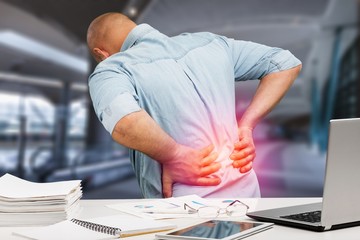Maintaining and Improving Function with Low Back Pain
by Drew Satterfield, PT, DPT
AzOPT Gilbert Clinic Manager and Doctor of Physical Therapy
It’s almost inevitable for us all to feel low back pain for one reason or either at some point in our life. Common symptoms include aching along the middle lower back or aching along one side or the other, sometimes even into the gluteal region.
Low back pain can be caused by a number of reasons – from being too sedentary to being very active without proper stability. If at any point your back pain is preventing you from enjoying your daily life, it’s best to seek out a physical therapist to get you back on track.
In the meantime, here is a list of beginner exercises to get you started and begin to help reduce your low back pain.
3 Stretches that Focus on Mobility of your Lumbar Spine
Lower Trunk Rotation
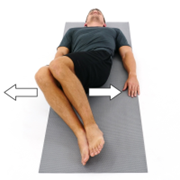 While lying on your back, bring your feet and knees together. Then begin rocking side to side, ensuring that your low back is gently rotating with your hips.
While lying on your back, bring your feet and knees together. Then begin rocking side to side, ensuring that your low back is gently rotating with your hips.
Piriformis Stretch
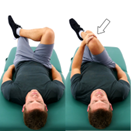 While lying on your back, place one ankle on the opposite knee. Then, pull your knee to the opposite shoulder. You should feel a strong but comfortable stretch in your hip region.
While lying on your back, place one ankle on the opposite knee. Then, pull your knee to the opposite shoulder. You should feel a strong but comfortable stretch in your hip region.
Seated Lumbar Flexion
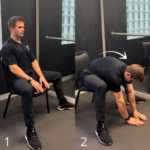 While sitting in a chair, lean forward and reach your hands to the floor. You should be comfortably bending from your spine, and feeling a comfortable stretch along your lower back.
While sitting in a chair, lean forward and reach your hands to the floor. You should be comfortably bending from your spine, and feeling a comfortable stretch along your lower back.
2 Exercises to Focus on Stability of your Lumbar Spine
These stretches are important to master because your lower back needs to be supported from your core musculature through all functional movements, such as picking up an object from the ground. It can also be some of the more difficult movements. If these provoke your pain, it would be best to consult a physical therapist to ensure you are performing the movement properly.
Abdominal Bracing
 Consider the muscles that activate in your lower stomach when you cough, laugh, or sneeze. These are the muscles that provide significant stability to your lumbar spine. It is important to be able to voluntarily control these muscles with functional movements. So, while lying on your back, brace your core as if you are bracing for impact to your gut, all while keeping your lower back in a neutral position (not too flexed or extended!) and taking controlled, small breaths. Hold for 6 seconds and repeat.
Consider the muscles that activate in your lower stomach when you cough, laugh, or sneeze. These are the muscles that provide significant stability to your lumbar spine. It is important to be able to voluntarily control these muscles with functional movements. So, while lying on your back, brace your core as if you are bracing for impact to your gut, all while keeping your lower back in a neutral position (not too flexed or extended!) and taking controlled, small breaths. Hold for 6 seconds and repeat.
Abdominal Brace with Marching
 Brace your core, then perform small marching movements, without letting your core “collapse”. Keep it packed in!
Brace your core, then perform small marching movements, without letting your core “collapse”. Keep it packed in!
Try These 3 Exercises to Strengthen Your Glutes and Hips
These exercises emphasize building or maintaining the strength of your glutes and hip musculature. Typically with lower back pain, these are the first muscle groups to become very weak – which will in turn give your lower back even less stability. Keep yourself strong!
Glute bridge
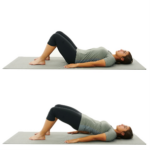 Squeeze your glutes, then raise your hips straight toward the ceiling. Slowly yourself back to the starting position.
Squeeze your glutes, then raise your hips straight toward the ceiling. Slowly yourself back to the starting position.
Clamshell
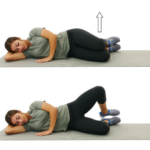 While lying on your side with your hips rolled forward and feet together, lift the top leg. Do not roll your hips back at all as you perform the movement. You should feel muscle working along your top hip.
While lying on your side with your hips rolled forward and feet together, lift the top leg. Do not roll your hips back at all as you perform the movement. You should feel muscle working along your top hip.
Adduction squeeze
 Grab your favorite pillow and crush it between your legs while lying on your back. Hold for 6 seconds and repeat.
Grab your favorite pillow and crush it between your legs while lying on your back. Hold for 6 seconds and repeat.
These exercises will provide you with a great starting point to ensure your core strength, leg strength, and lumbar mobility do not get worse while you are having low back pain. If you have been having back pain for a long time, try these exercises to get on the road to recovery by restoring functional mobility and strength. If you need further follow up, or have any questions on how you can reduce your back pain, reach out to a physical therapist near you or schedule with us online. We have 5 physical therapy clinics in Arizona ready to serve you!

